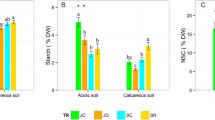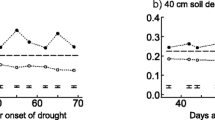Abstract
Aims
The objective of this study was to investigate the effects of future warming and drought on (1) the biochemical composition of above-ground biomass of forage plants (Festuca arundinacea and Dactylis glomerata), (2) the potential mineralization of this material in soil, and (3) its priming effect on native soil organic matter.
Methods
We sampled above-ground plant material from spring regrowth and summer regrowth of a climate change experiment. While in spring, the plants were well watered, the summer regrowth was exposed to drought and elevated temperature (+3 °C) by infrared heating of the canopy during 3 weeks. We assessed the elemental and isotopic composition, lignin and non-cellulosic carbohydrate content and composition of plant material grown under all three conditions. Its mineralization potential in soil and priming effects were evaluated during laboratory incubation.
Results
Warming had no significant effect on elemental and stable isotope composition of both plant materials. In contrast, it resulted in reduction of lignin content for both plant species and decrease of the lignin-to-N ratio for F. arundinacea and increased non-cellulosic carbohydrate content for D. glomerata. Summer regrowth was characterised by increase of δ13C values, which is consistent with variations in stomatal conductance due to water shortage. Moreover, summer drought induced an increase in N content leading to decrease of the C/N ratio and increase of lignin-to-N ratio of summer regrowth compared to spring regrowth. Differences in decomposition were small, while priming effects were more strongly altered by the different exposure to enviromental.
Conclusion
Our results provide direct experimental evidence that extreme climatic events (high temperature and precipitation deficit) have an influence on soil carbon storage particularly through their effect on priming of native soil organic matter induced by altered plant litter. These effects seem to be governed by alterations of stoichiometry and to a smaller extent by alterations of plant chemical composition.




Similar content being viewed by others
References
Aerts R, van Bodegom PM, Cornelissen JHC (2012) Litter stoichiometric traits of plant species of high-latitude ecosystems show high responsiveness to global change without causing strong variation in litter decomposition. New Phytol 196:181–188
Battaglia M, Beadle C, Loughhead S (1996) Photosynthetic temperature responses of Eucalyptus globulus and Eucalyptus nitens. Tree Physiol 16:81–89
Blagodatskaya E, Kuzyakov Y (2008) Mechanisms of real and apparent priming effects and their dependence on soil microbial biomass and community structure: critical review. Biol Fert Soils 45:115–131
Boyer JS (1970) Leaf enlargement and metabolic rates in corn, soybean, and sunflower at various leaf water potentials. Plant Physiol 46:233–235
Buxton D, Fales S (1994) Plant enviroment and qaulity. In: Fahey G (ed) Forage quality, evaluation and utilization. ASA, CCSA, SSSA, Madison, WI, pp 155–199
Campbell G (1985) Soil physics with basic transport models for soil-plant systems. Elsevier Science, Amsterdam, p 150
Chabbi A, Kogel-Knabner I, Rumpel C (2009) Stabilised carbon in subsoil horizons is located in spatially distinct parts of the soil profile. Soil Biol Biochem 41:256–261
Conant RT, Paustian K, Elliott ET (2001) Grassland management and conversion into grassland: effects on soil carbon. Ecol Appl 11:343–355
Cornwell WK, Cornelissen JHC, Amatangelo K, Dorrepaal E, Eviner VT, Godoy O, Hobbie SE, Hoorens B, Kurokawa H, Perez-Harguindeguy N, Quested HM, Santiago LS, Wardle DA, Wright IJ, Aerts R, Allison SD, van Bodegom P, Brovkin V, Chatain A, Callaghan TV, Diaz S, Garnier E, Gurvich DE, Kazakou E, Klein JA, Read J, Reich PB, Soudzilovskaia NA, Vaieretti MV, Westoby M (2008) Plant species traits are the predominant control on litter decomposition rates within biomes worldwide. Ecol Lett 11:1065–1071
Cutler JM, Rains DW, Loomis RS (1977) Importance of cell-size in water relations of plants. Physiol Plantarum 40:255–260
Duhme F, Hinckley TM (1992) Daily and seasonal variation in water relations of macchia shrubs and trees in France (Montpellier) and Turkey (Antalya). Vegetatio 100:185–198
Durand JL, Onillon B, Schnyder H, Rademacher I (1995) Drought effect on cellular and spatial parameters of leaf growth in Tall Fescue. J Exp Bot 46:1147–1155
Emmett BA, Beier C, Estiarte M (2004) The response of soil processes to climate change: results from manipulation studies of shrublands across and environmental gradient. Ecosystems 7:625–637
Farquhar GD, Ehleringer JR, Hubick KT (1989) Carbon isotope discrimination and photosynthesis. Annu Rev Plant Phys 40:503–537
Fay PA, Carlisle JD, Knapp AK, Blair JM, Collins SL (2000) Altering rainfall timing and quantity in a mesic grassland ecosystem: design and performance of rainfall manipulation shelters. Ecosystems 3:308–319
Fontaine S, Mariotti A, Abbadie L (2003) The priming effect of organic matter: a question of microbial competition? Soil Biol Biochem 35:837–843
Girardin C, Mariotti A (1991) Analyse isotopique du 13C en abondance naturelle dans le carbone organique: un système automatique avec robot préparateur. Cahiers ORSTOM Série Pédologie 371–380
Gonzalez-Dugo V, Durand JL, Gastal F, Picon-Cochard C (2005) Short-term response of the nitrogen nutrition status of tall fescue and Italian ryegrass swards under water deficit. Aust J Agr Res 56:1269–1276
Gonzalez-Dugo V, Zarco-Tejada P, Berni JAJ, Suarez L, Goldhamer D, Fereres E (2012) Almond tree canopy temperature reveals intra-crown variability that is water stress-dependent. Agr Forest Meteorol 154:156–165
Hedges JI, Ertel JR (1982) Characterization of lignin by gas capillary chromatography of cupric oxide oxidation products. Anal Chem 54:174–178
Henry HAL, Cleland EE, Field CB, Vitousek PM (2005) Interactive effects of elevated CO2, N deposition and climate change on plant litter quality in a California annual grassland. Oecologia 142:465–473
Hodge A, Millard P (1998) Effect of elevated CO2 on carbon partitioning and exudate release from Plantago lanceolata seedlings. Physiol Plantarum 103:280–286
Hoeppner SS, Dukes JS (2012) Interactive responses of old-field plant growth and composition to warming and precipitation. Glob Change Biol 18:1754–1768
Katayama A, Kai K, Fujie K (1998) Extraction efficiency, size distribution, colony formation and [H-3]-thymidine incorporation of bacteria directly extracted from soil. Soil Sci Plant Nutr 44:245–252
Kimball BA, Conley MM, Wang S, Lin X, Luo C, Morgan J, Smith D (2008) Infrared heater arrays for warming ecosystem field plots. Glob Change Biol 14:309–320
Kögel I, Bochter R (1985) Characterization of lignin in forest humus layers by high-performance liquid chromatography of cupric oxide oxidation products. Soil Biol Biochem 17:637–640
Kuzyakov Y, Friedel JK, Stahr K (2000) Review of mechanisms and quantification of priming effects. Soil Biol Biochem 32:1485–1498
Lindahl V, Bakken LR (1995) Evaluation of methods for extraction of bacteria from soil. FEMS Microbiol Ecol 16:135–142
Nguyen TT, Janik LJ, Raupach M (1991) Diffuse reflectance infrared forier-transform (DRIFT) spectroscopy in soil studies. Aust J Soil Res 29:49–67
Onillon B, Durand JL, Gastal F, Tournebize R (1995) Drought effects on growth and carbon partitioning in a tall fescue sward grown at different rates of nitrogen-fertilization. Eur J Agron 4:91–99
Poirier M, Durand JL, Volaire F (2012) Persistence and production of perennial grasses under water deficits and extreme temperatures: importance of intraspecific vs. interspecific variability. Glob Change Biol. doi:10.1111/j.1365-2486.2012.02800.x
Ramsay AJ (1984) Extraction of bacteria from soil - efficiency of shaking or ultrasonication as indicated by direct counts and autoradiography. Soil Biol Biochem 16:475–481
Risch A, Frank D (2007) Effects of increased soil water availability on grassland ecosystem carbon dioxide fluxes. Biogeochemistry 86:91–103
Rumpel C, Dignac M-F (2006) Gas chromatographic analysis of monosaccharides in a forest soil profile: analysis by gas chromatography after trifluoroacetic acid hydrolysis and reduction-acetylation. Soil Biol Biochem 38:1478–1481
Sanaullah M, Chabbi A, Lemaire G, Charrier X, Rumpel C (2010) How does plant leaf senescence of grassland species influence decomposition kinetics and litter compounds dynamics? Nutr Cycl Agroecosys 88:159–171
Sanaullah M, Blagodatskaya E, Chabbi A, Rumpel C, Kuzyakov Y (2011) Drought effects on microbial biomass and enzyme activities in the rhizosphere of grasses depend on plant community composition. Appl Soil Ecol 48:38–44
Sanaullah M, Chabbi A, Rumpel C, Kuzyakov Y (2012a) Carbon allocation in grassland communities under drought stress followed by 14C pulse labeling. Soil Biol Biochem 55:132–139
Sanaullah M, Rumpel C, Charrier X, Chabbi A (2012b) How does drought stress influence the decomposition of plant litter with contrasting quality in a grassland ecosystem? Plant Soil 352:277–288
Schuppler U, He PH, John PCL, Munns R (1998) Effect of water stress on cell division and cell-division-cycle 2-like cell-cycle kinase activity in wheat leaves. Plant Physiol 117:667–678
Seneviratne G (2000) Litter quality and nitrogen release in tropical agriculture: a synthesis. Biol Fert Soils 31:60–64
Stott PA, Stone DA, Allen MR (2005) Human contribution to the European heatwave of 2003. Nature 436:1200–1200
Willms WD, Beauchemin KA (1991) Cutting frequency and cutting height effects on forage quality of rough fescue and parry oat grass. Can J Anim Sci 71:87–96
Zavaleta ES, Shaw MR, Chiariello NR, Thomas BD, Cleland EE, Field CB, Mooney HA (2003) Grassland responses to three years of elevated temperature, CO2, precipitation, and N deposition. Ecol Monogr 73:585–604
Acknowledgments
We acknowledge Higher Education Commission (HEC) of Pakistan and European community’s Seventh Framework programme (FP2007-2013) under grant agreement no. 262060 (ExpeER http://www.expeeronline.eu/) for their financial support.
Author information
Authors and Affiliations
Corresponding author
Additional information
Responsible Editor: Per Ambus.
Rights and permissions
About this article
Cite this article
Sanaullah, M., Chabbi, A., Girardin, C. et al. Effects of drought and elevated temperature on biochemical composition of forage plants and their impact on carbon storage in grassland soil. Plant Soil 374, 767–778 (2014). https://doi.org/10.1007/s11104-013-1890-y
Received:
Accepted:
Published:
Issue Date:
DOI: https://doi.org/10.1007/s11104-013-1890-y




